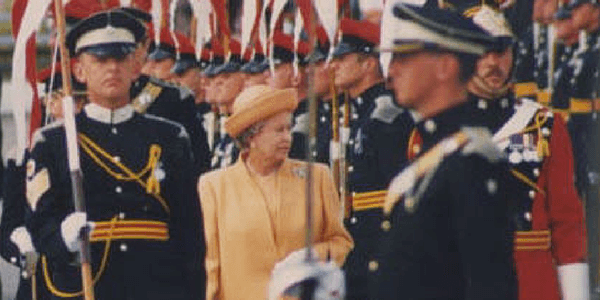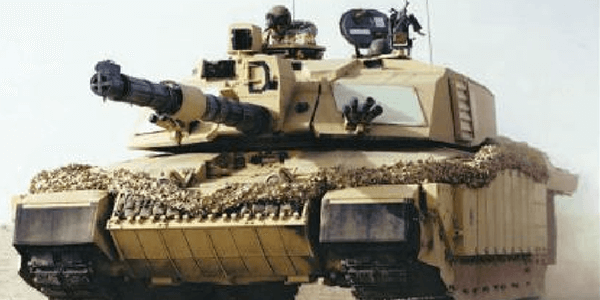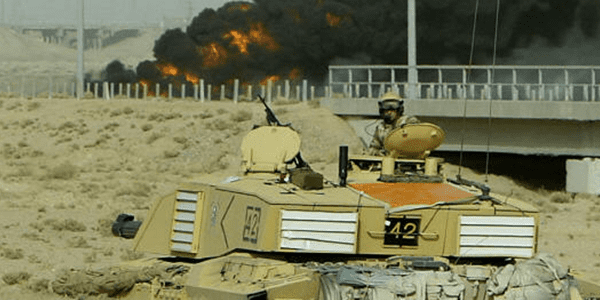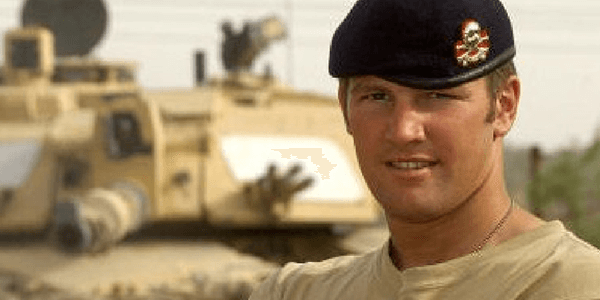The Queen’s Royal Lancers
The 16th/5th and 17th/21st Lancers were amalgamated in 1993 to form The Queen’s Royal Lancers. After amalgamation QRL served in Cyprus, Bosnia and Kosovo, and in Iraq and Afghanistan, earning a reputation as a leading armoured regiment standing in the front line of the British Army’s fighting and peace keeping capabilities.

Amalgamation 1993
On 25th June 1993, the 16th/5th The Queen’s Royal Lancers and the 17th/21st Lancers were amalgamated in the presence of Her Majesty the Queen to form The Queen’s Royal Lancers. The Regiment was proud to have Her Majesty as its Colonel-in-Chief, a position she has held since 1947 with the 16th/5th. HRH Princess Alexandra was Colonel-in-Chief of the 17th/21st and became Deputy Colonel-in-Chief of the new regiment.
The Regiment retained the famous Motto (cap badge) of the 17th/21st (represented by the Death’s Head skull and crossed thighbones with the scroll ‘OR GLORY’ below), with the addition of a scarlet backing from the 16th/5th.
After amalgamation the Regiment, equipped with Challenger 1 tanks, moved to Osnabruck, Germany. July 1994 saw the final parade of The Queen’s Royal Lancers Band, which then amalgamated with the 9th/12th Lancers Band to form the Band of the Royal Lancers.
1994-2002
The Regiment deployed to Cyprus in December 1994 in a UN peacekeeping role, followed shortly by C Squadron’s deployment to Maglai, Bosnia, in April 1995. 1997 saw the Regiment deployed to Canada as the opposition force in the British Army Training Unit Suffield (BATUS). In 1998 the Regiment completed two major exercises in Poland. In the same year B Squadron deployed to Bosnia as part of the NATO Stabilisation Force (SFOR). Also that year The Queen’s Royal Lancers Battle Group and was present throughout the highly volatile period of the Kosovo campaign. On return to Germany the Regiment undertook conversion to the British Army’s new Challenger 2 tank.
In 2001 the Regiment deployed to Cyprus again as part of the UN Peacekeeping Force based in the capital, Nicosia. C Squadron completed another tour of Bosnia in 2002/2002 and The Queen’s Royal Lancers Battle Group deployed to Kosovo as part of the NATO-led Kosovo force.
2003
2003 saw B and C Squadrons deploy with the 1st Battalion Royal Regiment of Fusiliers Battle Group on the liberation of Iraq on Operation TELIC, earning the Regiment the Battle Honour Iraq 2003, its first since amalgamation. Throughout the tour they fought with considerable success on Challenger 2 and were the only Sabre squadrons to be given their own areas of operation by 7 Armoured Brigade.
While B and C Squadrons were busy with this, the remainder of the Regiment not only conducted a full training year but also moved from Osnabruck to Catterick Garrison in North Yorkshire, the first time the Regiment had been based in England since amalgamation.


2004
In 2004 A and D Squadrons also deployed to Iraq. A Squadron supported 1st Battalion Princess of Wales Royal Regiment in the trouble spot of Al Amarah and were regularly engaged in small arms contacts including the notorious defence of CIMIC house in Al Amarah itself. D Squadron deployed with 1st Battalion Royal Welch Fusiliers initially in Um Qasar and then Az Zubayr. They were later cut to 1st Regiment Royal Horse Artillery in Basrah Palace and assisted in putting down Mahdi uprisings of August 2004. Both squadrons had the opportunity to deploy their Challenger 2s during the tour and were engaged in a number of contacts in support of operations.
At the end of 2004 the Regiment was warned off to re-role to Formation Reconnaissance. This involved the platform conversion of every member of the Regiment to gunners and drivers to Combat Vehicle Reconnaissance (Tracked) – Scimitar, Spartan, Swingfire, Sultan and Samaritan.
A Squadron moved from Reconnaissance soldiers to Warrior crew deployed in Iraq on Op TELIC 7 – the first non-infantry sub unit to be given the task of crewing Warrior. This is of particular note as the Squadron was given only eight weeks notice from warning off for operations to being on the ground in Iraq. In this time the Squadron converted gunners, drivers and commanders, conducted pre-deployment training and took over its role in Iraq.
The Regiment
The Queen’s Royal Lancers was an armoured regiment based in Catterick, with Her Majesty the Queen as its Colonel-in-Chief.
Death or Glory
The cap badge is known as ‘the Motto’ because of the skull and crossed bones above ‘OR GLORY’:
The QRL
In recent years The Queen’s Royal Lancers has deployed to Iraq and Afghanistan.
Regimental Association
For all who have served in The 9th/12th Lancers, The 16th/5th Lancers, The 17th/21st Lancers or The Queen’s Royal Lancers.

2006-2008
In February 2006 the Regiment was warned off for operations in Iraq on Op TELIC 9. The mission was to patrol the Iraq/Iran border using CVR(T) and Land Rovers with Weapons Mount Installation Kits (known as WMIKs). This task was unprecedented in recent years with the Battle Group operation several hundred kilometres away from the main coalition base in Basrah and spending seven months deployed in the desert. To date the Regiment remains the only unit to have spent such a prolonged period of time deployed in this role – evidence, if any were needed, of the completeness of the conversion to recce.
Recovery completed, the Regiment next got to grips with the conversion to the new army communication system, BOWMAN, vital in the modern day battlespace. This was another huge task.
A Squadron has deployed to Afghanistan as Viking crew – the first time for non Royal Marine or infantry. B Squadron continued this trend of firsts by becoming the first RAC squadron to carry out Public Duties in London.
The Regiment continued to increase its skill sets, boasting snipers, forward air controllers (FACS), assault troops, Javelin crew, as well as still regularly sending instructors to the Gunnery, Signals and Driving and Maintenance Schools.
Tours of Duty
During it’s short history, The Queen’s Royal Lancers served in Germany, Cyprus, Canada, Poland, Bosnia, Kosovo, Iraq and Afghanistan earning a reputation as one of Britain’s leading armoured regiments in the front line of the British Army’s fighting and peacekeeping capabilities.
As part of the Army 2020 reforms intended to reduce the size of the British Army in line with the Strategic Defence and Security Review, it was announced that the 9th/12th Royal Lancers would amalgamate with the Queen’s Royal Lancers to form a single regiment, the Royal Lancers on 2 May 2015

